Parsing documents with AI_PARSE_DOCUMENT¶
AI_PARSE_DOCUMENT est une fonction AI SQL Cortex qui extrait du texte, des données et des éléments de mise en page dans des documents de manière très fidèle. Utilisez-la pour alimenter les workflows de traitement intelligent des documents, notamment :
Optimisation du pipeline RAG : l’extraction haute fidélité garantit que les systèmes de récupération trouvent un contenu pertinent avec le contexte approprié, ce qui améliore considérablement la qualité des réponses.
Création de la base de connaissances : la sortie structurée permet la recherche sémantique et le raisonnement de l’AI à travers de grandes collections de documents.
Automated document processing: Extract entities, generate summaries, and perform analysis on complex documents using other Cortex AI Functions.
Workflows d’AI multilingues : traitez des documents en douze langues avec une qualité constante pour des applications d’entreprise mondiales.
AI_PARSE_DOCUMENT¶
AI_PARSE_DOCUMENT is a fully managed SQL function that extracts text and layout from documents stored on internal or external stages, preserving structure like tables, headers, and reading order. See Create stage for media files for information on creating a stage suitable for storing documents.
Under the hood, AI_PARSE_DOCUMENT orchestrates advanced AI models for document understanding and layout analysis, processing complex multi-page documents with high fidelity.
La fonction AI_PARSE_DOCUMENT propose deux modes de traitement des documents PDF :
le mode LAYOUT est le choix préféré dans la plupart des cas d’utilisation, en particulier pour les documents complexes. il est spécifiquement optimisé pour l’extraction de texte et d’éléments de mise en page tels que des tables, ce qui en fait la meilleure option pour créer des bases de connaissances, optimiser les systèmes de récupération et améliorer les applications basées sur l’AI.
le mode OCR est recommandé pour une extraction de texte rapide et de haute qualité à partir de documents tels que les manuels, les accords ou les contrats, les pages d’informations sur les produits, les polices d’assurance et les réclamations, et les documents SharePoint.
Pour les deux modes, utilisez l’option page_split pour diviser des documents de plusieurs pages en pages distinctes dans la réponse. Vous pouvez également utiliser l’option page_filter pour ne traiter que les pages spécifiées. (Si vous utilisez page_filter, page_split est implicite, et vous n’avez pas besoin de le définir explicitement).
AI_PARSE_DOCUMENT est évolutif horizontalement, ce qui permet un traitement efficace par lots de plusieurs documents simultanément. Les documents peuvent être traités directement à partir du stockage d’objets pour éviter les mouvements de données inutiles.
Note
AI_PARSE_DOCUMENT est actuellement incompatible avec les politiques de réseau personnalisées.
Exemples¶
Exemple de mise en page simple¶
Cet exemple utilise le mode LAYOUT de AI_PARSE_DOCUMENT pour traiter un document de recherche à deux colonnes. Le paramètre page_split est défini sur TRUE et sépare le document en plusieurs pages dans la réponse. AI_PARSE_DOCUMENT renvoie le contenu au format Markdown. ce qui suit montre le rendu markdown pour l’une des pages traitées (index de page 4 dans la sortie JSON) à côté de la page d’origine. Le Markdown brut est affiché dans la réponse JSON suivant les images.
Page du document d’origine |
Markdown extrait rendu en tant que HTML |
|---|---|
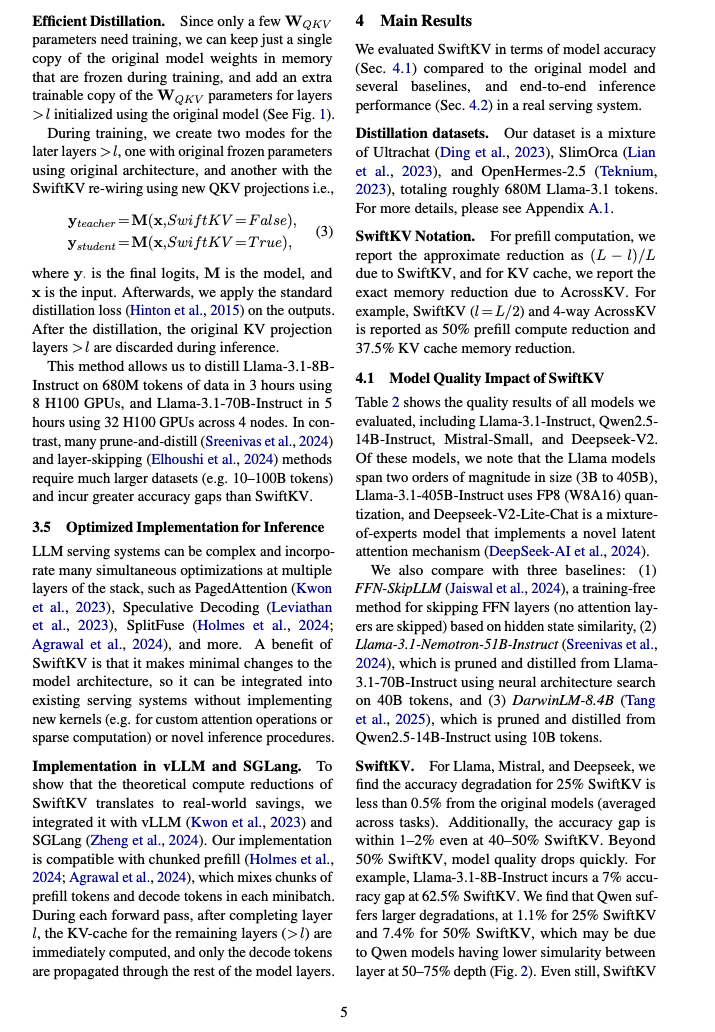
|
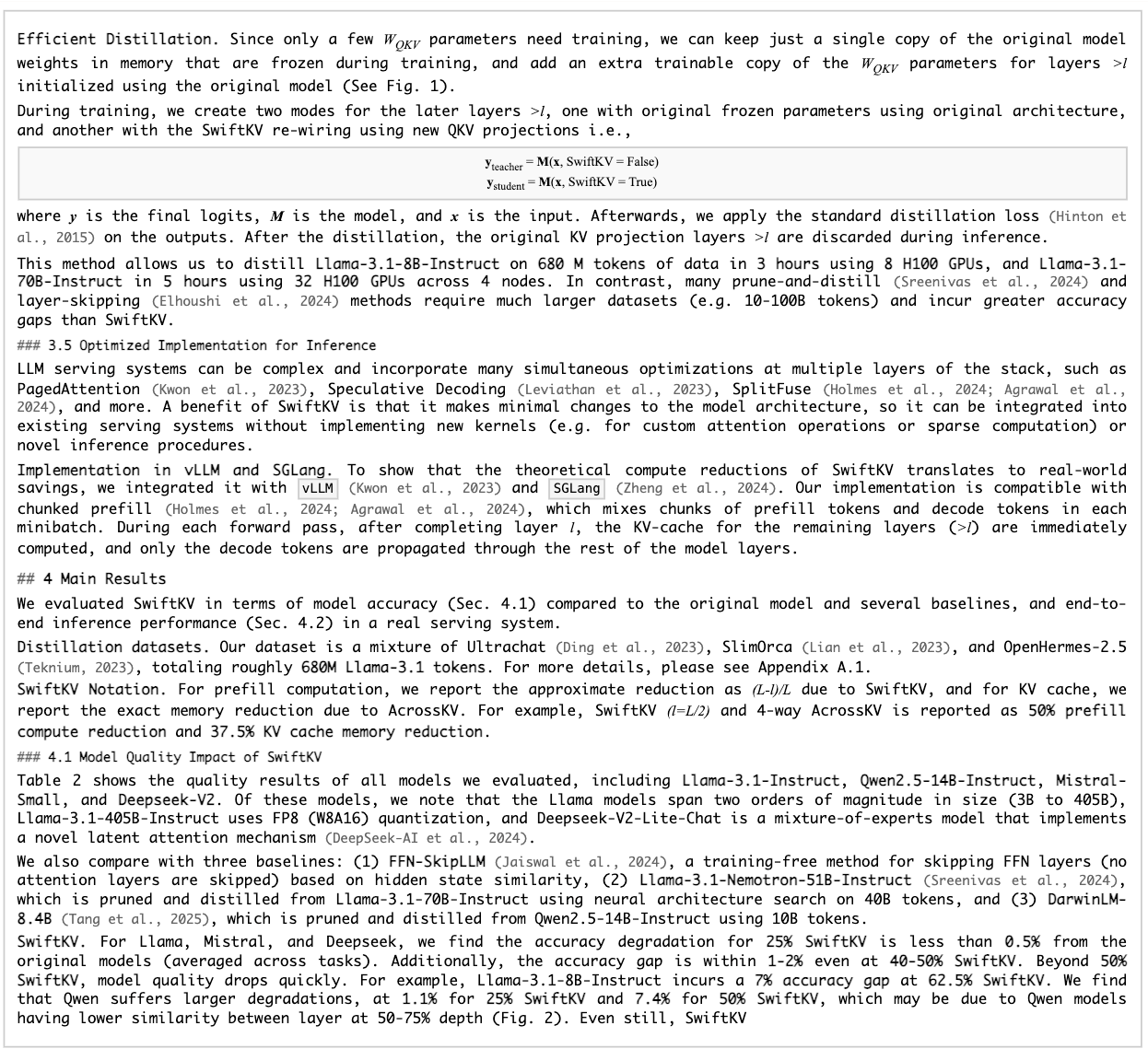
|
Astuce
Pour voir l’une de ces images à une taille plus lisible, sélectionnez-la en cliquant dessus ou en la touchant.
Ce qui suit est la commande SQL pour traiter le document original :
SELECT AI_PARSE_DOCUMENT (
TO_FILE('@docs.doc_stage','research-paper-example.pdf'),
{'mode': 'LAYOUT' , 'page_split': true}) AS research_paper_example;
La réponse de AI_PARSE_DOCUMENT est un objet JSON contenant des métadonnées et du texte des pages du document, comme les suivants. Certains objets de page ont été omis par souci de brièveté.
{
"metadata": {
"pageCount": 19
},
"pages": [
{
"content": "# SwiftKV: Fast Prefill-Optimized Inference with Knowledge-Preserving Model Transformation \n\nAurick Qiao
Zhewei Yao Samyam Rajbhandari Yuxiong He<br>Snowflake AI Research<br>San Mateo, CA, United States<br>Correspondence:
aurick.qiao@ snowflake.com\n\n\n#### Abstract\n\nLLM inference for enterprise applications, such as summarization, RAG,
and code-generation, typically observe much longer prompt than generations, leading to high prefill cost and response
latency. We present SwiftKV, a novel model transformation and distillation procedure targeted at reducing the prefill
compute (in FLOPs) of prompt tokens while preserving high generation quality. First, SwiftKV prefills later layers' KV
cache using an earlier layer's output, allowing prompt tokens to skip those later layers. Second, SwiftKV employs a
lightweight knowledge-preserving distillation procedure that can adapt existing LLMs with minimal accuracy impact. Third,
SwiftKV can naturally incorporate KV cache compression to improve inference performance in low-memory scenarios. Our
comprehensive experiments show that SwiftKV can effectively reduce prefill computation by $25-50 \\%$ across several LLM
families while incurring minimum quality degradation. In the end-to-end inference serving, SwiftKV realizes up to $2
\\times$ higher aggregate throughput and $60 \\%$ lower time per output token. It can achieve a staggering 560 TFlops/GPU
of normalized inference throughput, which translates to 16 K tokens/s for Llama-3.1-70B. SwiftKV is open-sourced at
https://github . com/snowflakedb/arctictraining.\n\n\n## 1 Introduction\n\nLarge Language Models (LLMs) are now an
integral enabler of enterprise applications and offerings, including code and data co-pilots (Chen et al., 2021; Pourreza
and Rafiei, 2024), retrieval augmented generation (RAG) (Lewis et al., 2020; Lin et al., 2024), summarization (Pu et al.,
2023; Zhang et al., 2024), and agentic workflows (Wang et al., 2024; Schick et al., 2023). However, the cost and speed of
inference determine their practicality, and improving the throughput and latency of LLM inference has become increasingly
important.\n\nWhile prior works, such as model pruning (Ma et al., 2023; Sreenivas et al., 2024), KV cache compression
(Hooper et al., 2024; Shazeer, 2019; Ainslie et al., 2023b; Chang et al., 2024), and sparse attention (Zhao et al., 2024;
Jiang et al., 2024), have been developed to accelerate LLM inference, they typically significantly degrade the model
quality or work best in niche scenarios, such as lowmemory environments or extremely long contexts requests (e.g. $>100
\\mathrm{~K}$ tokens). On the other hand, production deployments are often compute-bound rather than memory-bound, and
such long-context requests are rare amongst diverse enterprise use cases (e.g. those observed at Snowflake).\n\nIn this
paper, we take a different approach to improving LLM inference based on the key observation that typical enterprise
workloads process more input tokens than output tokens. For example, tasks like code completion, text-to-SQL,
summarization, and RAG each submit long prompts but produce fewer output tokens (a 10:1 ratio with average prompt length
between 500 and 1000 is observed in our production). In these scenarios, inference throughput and latency are often
dominated by the cost of prompt processing (i.e. prefill), and reducing this cost is key to improving their performance.
\n\nBased on this observation, we designed SwiftKV, which improves throughput and latency by reducing the prefill
computation for prompt tokens. SwiftKV (Fig. 1) consists of three key components:\n\nModel transformation. SwiftKV rewires
an existing LLM so that the prefill stage during inference can skip a number of later transformer layers, and their KV
cache are computed by the last unskipped layer. This is motivated by the observation that the hidden states of later
layers do not change significantly (see Sec. 3.2 and (Liu et al., 2024b)). With SwiftKV, prefill compute is reduced by
approximately the number of layers skipped.\n\nOptionally, for low-memory scenarios, we",
"index": 0
},
...
{
"content": "Efficient Distillation. Since only a few $\\mathbf{W}_{Q K V}$ parameters need training, we can keep just a
single copy of the original model weights in memory that are frozen during training, and add an extra trainable copy of
the $\\mathbf{W}_{Q K V}$ parameters for layers $>l$ initialized using the original model (See Fig. 1).\n\nDuring
training, we create two modes for the later layers $>l$, one with original frozen parameters using original architecture,
and another with the SwiftKV re-wiring using new QKV projections i.e.,\n\n$$\n\\begin{aligned}\n& \\mathbf{y}_{\\text
{teacher }}=\\mathbf{M}(\\mathbf{x}, \\text { SwiftKV }=\\text { False }) \\\\\n& \\mathbf{y}_{\\text {student }}=\\mathbf
{M}(\\mathbf{x}, \\text { SwiftKV }=\\text { True })\n\\end{aligned}\n$$\n\nwhere $\\mathbf{y}$ is the final logits,
$\\mathbf{M}$ is the model, and $\\mathbf{x}$ is the input. Afterwards, we apply the standard distillation loss (Hinton et
al., 2015) on the outputs. After the distillation, the original KV projection layers $>l$ are discarded during inference.
\n\nThis method allows us to distill Llama-3.1-8BInstruct on 680 M tokens of data in 3 hours using 8 H100 GPUs, and
Llama-3.1-70B-Instruct in 5 hours using 32 H100 GPUs across 4 nodes. In contrast, many prune-and-distill (Sreenivas et
al., 2024) and layer-skipping (Elhoushi et al., 2024) methods require much larger datasets (e.g. 10-100B tokens) and incur
greater accuracy gaps than SwiftKV.\n\n### 3.5 Optimized Implementation for Inference\n\nLLM serving systems can be
complex and incorporate many simultaneous optimizations at multiple layers of the stack, such as PagedAttention (Kwon et
al., 2023), Speculative Decoding (Leviathan et al., 2023), SplitFuse (Holmes et al., 2024; Agrawal et al., 2024), and
more. A benefit of SwiftKV is that it makes minimal changes to the model architecture, so it can be integrated into
existing serving systems without implementing new kernels (e.g. for custom attention operations or sparse computation) or
novel inference procedures.\n\nImplementation in vLLM and SGLang. To show that the theoretical compute reductions of
SwiftKV translates to real-world savings, we integrated it with vLLM (Kwon et al., 2023) and SGLang (Zheng et al., 2024).
Our implementation is compatible with chunked prefill (Holmes et al., 2024; Agrawal et al., 2024), which mixes chunks of
prefill tokens and decode tokens in each minibatch. During each forward pass, after completing layer $l$, the KV-cache for
the remaining layers ( $>l$ ) are immediately computed, and only the decode tokens are propagated through the rest of the
model layers.\n\n## 4 Main Results\n\nWe evaluated SwiftKV in terms of model accuracy (Sec. 4.1) compared to the original
model and several baselines, and end-to-end inference performance (Sec. 4.2) in a real serving system.\n\nDistillation
datasets. Our dataset is a mixture of Ultrachat (Ding et al., 2023), SlimOrca (Lian et al., 2023), and OpenHermes-2.5
(Teknium, 2023), totaling roughly 680M Llama-3.1 tokens. For more details, please see Appendix A.1.\n\nSwiftKV Notation.
For prefill computation, we report the approximate reduction as $(L-l) / L$ due to SwiftKV, and for KV cache, we report
the exact memory reduction due to AcrossKV. For example, SwiftKV $(l=L / 2)$ and 4-way AcrossKV is reported as $50 \\%$
prefill compute reduction and $37.5 \\% \\mathrm{KV}$ cache memory reduction.\n\n### 4.1 Model Quality Impact of
SwiftKV\n\nTable 2 shows the quality results of all models we evaluated, including Llama-3.1-Instruct, Qwen2.
5-14B-Instruct, Mistral-Small, and Deepseek-V2. Of these models, we note that the Llama models span two orders of
magnitude in size (3B to 405B), Llama-3.1-405B-Instruct uses FP8 (W8A16) quantization, and Deepseek-V2-Lite-Chat is a
mixture-of-experts model that implements a novel latent attention mechanism (DeepSeek-AI et al., 2024).\n\nWe also compare
with three baselines: (1) FFN-SkipLLM (Jaiswal et al., 2024), a training-free method for skipping FFN layers (no attention
layers are skipped) based on hidden state similarity, (2) Llama-3.1-Nemotron-51B-Instruct (Sreenivas et al., 2024), which
is pruned and distilled from Llama-3.1-70B-Instruct using neural architecture search on 40B tokens, and (3) DarwinLM-8.4B
(Tang et al., 2025), which is pruned and distilled from Qwen2.5-14B-Instruct using 10B tokens.\n\nSwiftKV. For Llama,
Mistral, and Deepseek, we find the accuracy degradation for $25 \\%$ SwiftKV is less than $0.5 \\%$ from the original
models (averaged across tasks). Additionally, the accuracy gap is within $1-2 \\%$ even at $40-50 \\%$ SwiftKV. Beyond $50
\\%$ SwiftKV, model quality drops quickly. For example, Llama-3.1-8B-Instruct incurs a 7\\% accuracy gap at $62.5 \\%$
SwiftKV. We find that Qwen suffers larger degradations, at $1.1 \\%$ for $25 \\%$ SwiftKV and $7.4 \\%$ for $50 \\%$
SwiftKV, which may be due to Qwen models having lower simularity between layer at 50-75\\% depth (Fig. 2). Even still,
SwiftKV",
"index": 4
},
...
]
}
Exemple d’extraction de la structure de table¶
Cet exemple illustre l’extraction de la mise en page structurelle, y compris une table, à partir d’un formulaire 10-K. le schéma suivant montre les résultats rendus pour l’une des pages traitées (index de page 28 dans la sortie JSON).
Page du document d’origine |
Markdown extrait rendu en tant que HTML |
|---|---|
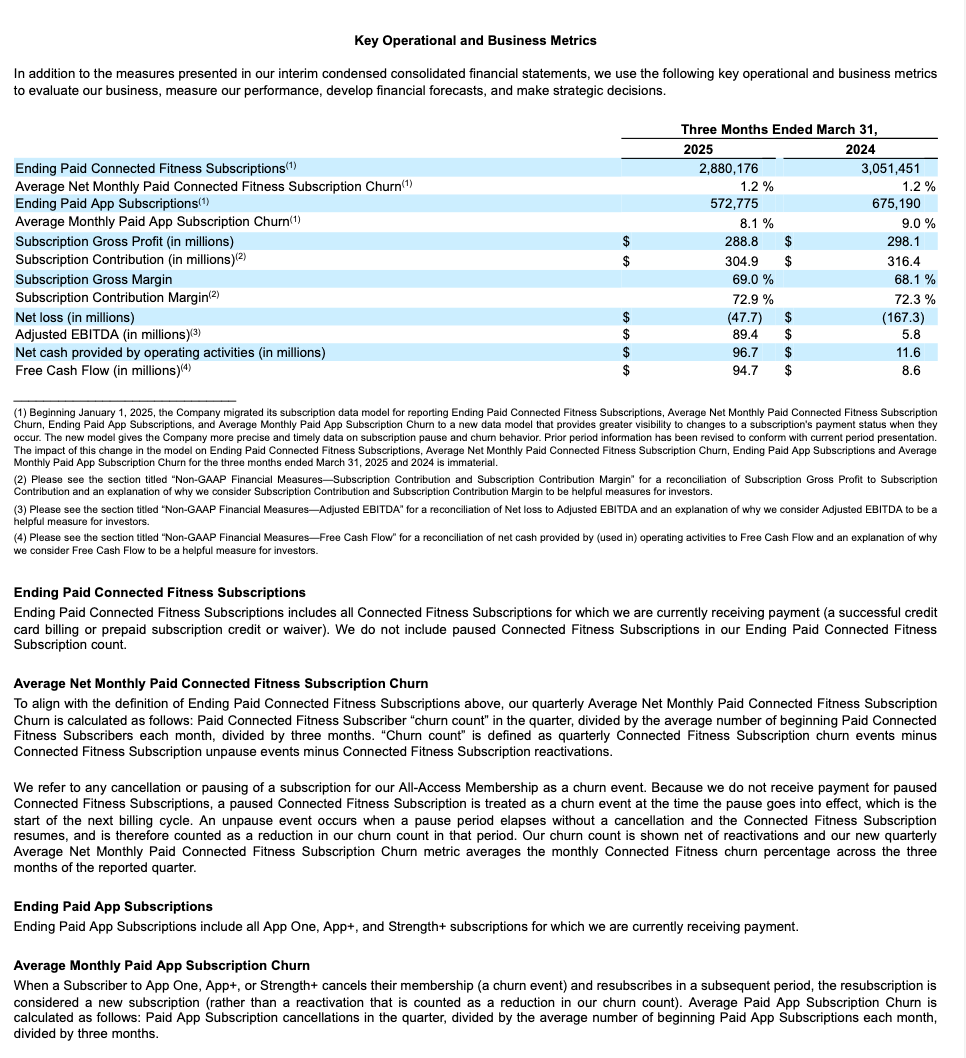
|
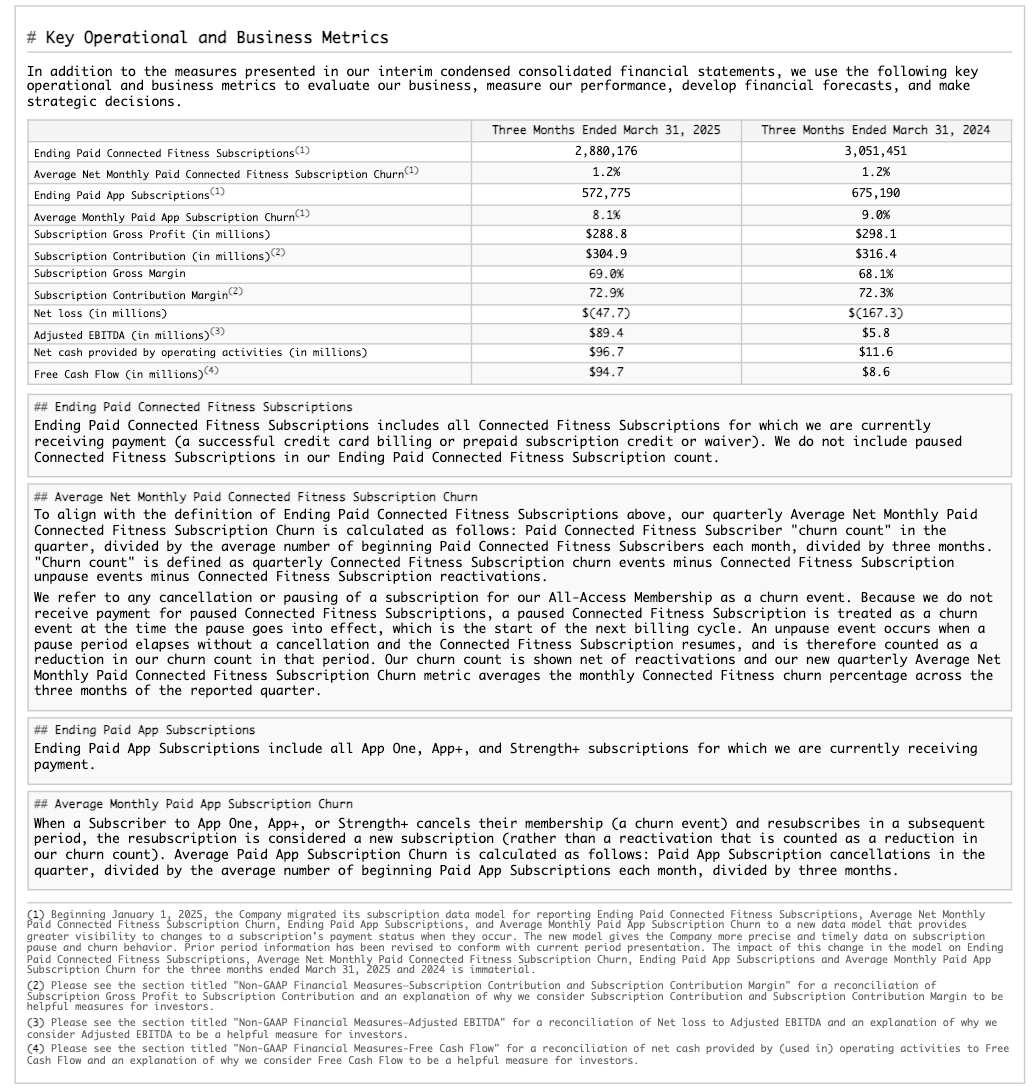
|
Astuce
Pour voir l’une de ces images à une taille plus lisible, sélectionnez-la en cliquant dessus ou en la touchant.
Ce qui suit est la commande SQL pour traiter le document original :
SELECT AI_PARSE_DOCUMENT (
TO_FILE('@docs.doc_stage','10K-example.pdf'),
{'mode': 'LAYOUT', 'page_split': true}) AS sec_10k_example;
La réponse de AI_PARSE_DOCUMENT est un objet JSON contenant des métadonnées et du texte des pages du document, comme les suivants. Les résultats pour toutes les pages, sauf la page précédemment affichée, ont été omis par souci de brièveté.
{
"metadata": {
"pageCount": 53
},
"pages": [
{
"content": ...
"index": 0
},
....
{
"content": "# Key Operational and Business Metrics \n\nIn addition to the measures presented in our interim condensed
consolidated financial statements, we use the following key operational and business metrics to evaluate our business,
measure our performance, develop financial forecasts, and make strategic decisions.\n\n| | Three Months Ended March 31, | |
\n| :--: | :--: | :--: |\n| | 2025 | 2024 |\n| Ending Paid Connected Fitness Subscriptions ${ }^{(1)}$ | 2,880,176 | $3,051,
451$ |\n| Average Net Monthly Paid Connected Fitness Subscription Churn ${ }^{(1)}$ | $1.2 \\%$ | $1.2 \\%$ |\n| Ending Paid
App Subscriptions ${ }^{(1)}$ | 572,775 | 675,190 |\n| Average Monthly Paid App Subscription Churn ${ }^{(1)}$ | $8.1 \\%$ |
$9.0 \\%$ |\n| Subscription Gross Profit (in millions) | \\$ 288.8 | \\$ 298.1 |\n| Subscription Contribution (in millions) $
{ }^{(2)}$ | \\$ 304.9 | \\$ 316.4 |\n| Subscription Gross Margin | $69.0 \\%$ | $68.1 \\%$ |\n| Subscription Contribution
Margin ${ }^{(2)}$ | $72.9 \\%$ | $72.3 \\%$ |\n| Net loss (in millions) | \\$ $(47.7)$ | \\$ $(167.3)$ |\n| Adjusted EBITDA
(in millions) ${ }^{(3)}$ | \\$ 89.4 | \\$ 5.8 |\n| Net cash provided by operating activities (in millions) | \\$ 96.7 | \\$
11.6 |\n| Free Cash Flow (in millions) ${ }^{(4)}$ | \\$ 94.7 | \\$ 8.6 |\n\n[^0]\n## Ending Paid Connected Fitness
Subscriptions\n\nEnding Paid Connected Fitness Subscriptions includes all Connected Fitness Subscriptions for which we are
currently receiving payment (a successful credit card billing or prepaid subscription credit or waiver). We do not include
paused Connected Fitness Subscriptions in our Ending Paid Connected Fitness Subscription count.\n\n## Average Net Monthly
Paid Connected Fitness Subscription Churn\n\nTo align with the definition of Ending Paid Connected Fitness Subscriptions
above, our quarterly Average Net Monthly Paid Connected Fitness Subscription Churn is calculated as follows: Paid Connected
Fitness Subscriber \"churn count\" in the quarter, divided by the average number of beginning Paid Connected Fitness
Subscribers each month, divided by three months. \"Churn count\" is defined as quarterly Connected Fitness Subscription
churn events minus Connected Fitness Subscription unpause events minus Connected Fitness Subscription reactivations.\n\nWe
refer to any cancellation or pausing of a subscription for our All-Access Membership as a churn event. Because we do not
receive payment for paused Connected Fitness Subscriptions, a paused Connected Fitness Subscription is treated as a churn
event at the time the pause goes into effect, which is the start of the next billing cycle. An unpause event occurs when a
pause period elapses without a cancellation and the Connected Fitness Subscription resumes, and is therefore counted as a
reduction in our churn count in that period. Our churn count is shown net of reactivations and our new quarterly Average Net
Monthly Paid Connected Fitness Subscription Churn metric averages the monthly Connected Fitness churn percentage across the
three months of the reported quarter.\n\n## Ending Paid App Subscriptions\n\nEnding Paid App Subscriptions include all App
One, App+, and Strength+ subscriptions for which we are currently receiving payment.\n\n## Average Monthly Paid App
Subscription Churn\n\nWhen a Subscriber to App One, App+, or Strength+ cancels their membership (a churn event) and
resubscribes in a subsequent period, the resubscription is considered a new subscription (rather than a reactivation that is
counted as a reduction in our churn count). Average Paid App Subscription Churn is calculated as follows: Paid App
Subscription cancellations in the quarter, divided by the average number of beginning Paid App Subscriptions each month,
divided by three months.\n\n\n[^0]: (1) Beginning January 1, 2025, the Company migrated its subscription data model for
reporting Ending Paid Connected Fitness Subscriptions, Average Net Monthly Paid Connected Fitness Subscription Churn, Ending
Paid App Subscriptions, and Average Monthly Paid App Subscription Churn to a new data model that provides greater visibility
to changes to a subscription's payment status when they occur. The new model gives the Company more precise and timely data
on subscription pause and churn behavior. Prior period information has been revised to conform with current period
presentation. The impact of this change in the model on Ending Paid Connected Fitness Subscriptions, Average Net Monthly
Paid Connected Fitness Subscription Churn, Ending Paid App Subscriptions and Average Monthly Paid App Subscription Churn for
the three months ended March 31, 2025 and 2024 is immaterial.\n (2) Please see the section titled \"Non-GAAP Financial
Measures—Subscription Contribution and Subscription Contribution Margin\" for a reconciliation of Subscription Gross Profit
to Subscription Contribution and an explanation of why we consider Subscription Contribution and Subscription Contribution
Margin to be helpful measures for investors.\n (3) Please see the section titled \"Non-GAAP Financial Measures—Adjusted
EBITDA\" for a reconciliation of Net loss to Adjusted EBITDA and an explanation of why we consider Adjusted EBITDA to be a
helpful measure for investors.\n (4) Please see the section titled \"Non-GAAP Financial Measures-Free Cash Flow\" for a
reconciliation of net cash provided by (used in) operating activities to Free Cash Flow and an explanation of why we
consider Free Cash Flow to be a helpful measure for investors.",
"index": 28
},
...
{
"content": "# CERTIFICATION OF PRINCIPAL FINANCIAL OFFICER PURSUANT TO 18 U.S.C. SECTION 1350, AS ADOPTED PURSUANT TO
SECTION 906 OF THE SARBANES-OXLEY ACT OF 2002 \n\nI, Elizabeth F Coddington, Chief Financial Officer of Peloton Interactive,
Inc. (the \"Company\"), do hereby certify, pursuant to 18 U.S.C. Section 1350, as adopted pursuant to Section 906 of the
Sarbanes-Oxley Act of 2002, that to the best of my knowledge:\n\n1. the Quarterly Report on Form 10-Q of the Company for the
fiscal quarter ended March 31, 2025 (the \"Report\") fully complies with the requirements of Section 13(a) or 15(d) of the
Securities Exchange Act of 1934, as amended; and\n2. the information contained in the Report fairly presents, in all
material respects, the financial condition, and results of operations of the Company.\n\nDate: May 8, 2025\n\nBy: /s/
Elizabeth F Coddington\nElizabeth F Coddington\nChief Financial Officer\n(Principal Financial Officer)",
"index": 52
}
]
}
Exemple de diaporama¶
Cet exemple illustre l’extraction de la mise en page structurelle à partir d’une présentation. ci-dessous, nous montrons les résultats rendus pour l’une des diapositives traitées (index de page 17 dans la sortie JSON).
Diapositive dans le document original |
Markdown extrait rendu en tant que HTML |
|---|---|
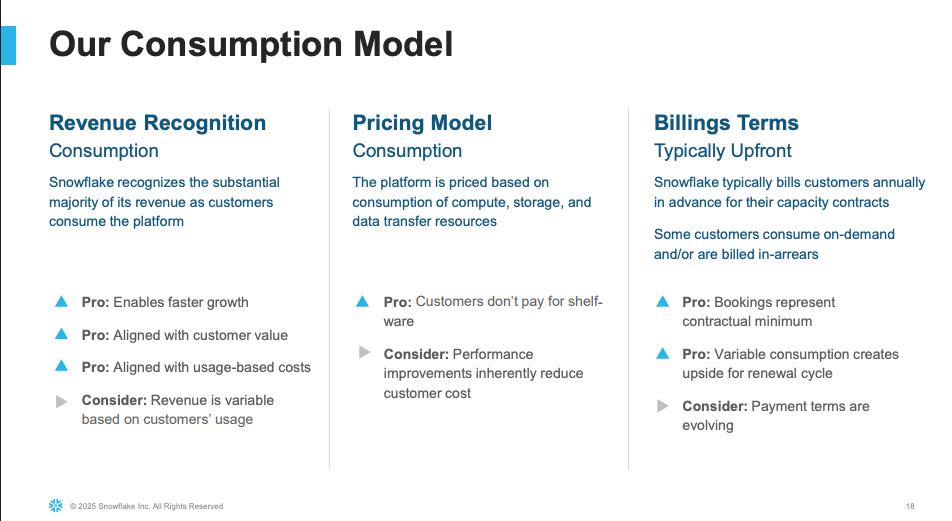
|
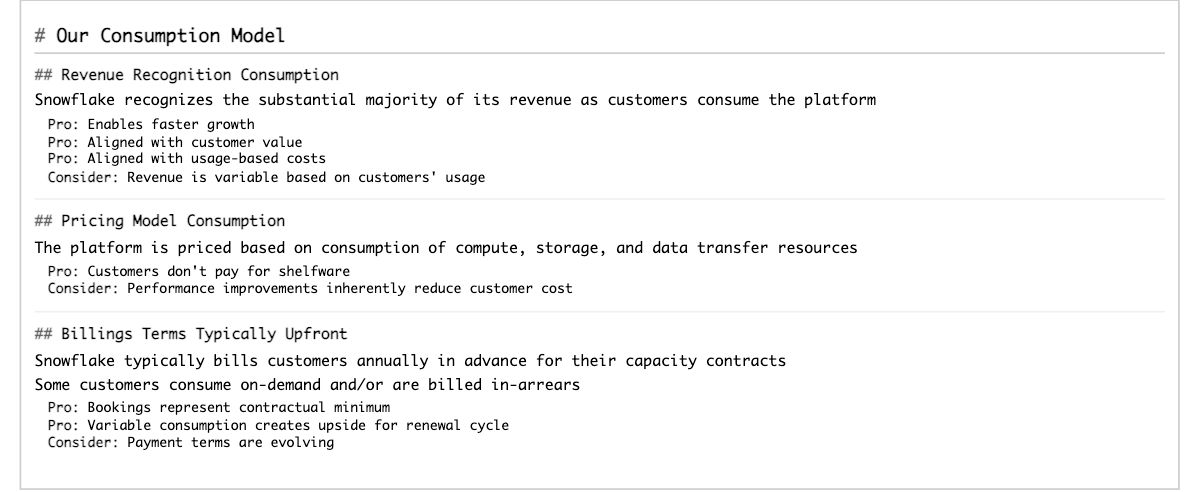
|
Astuce
Pour voir l’une de ces images à une taille plus lisible, sélectionnez-la en cliquant dessus ou en la touchant.
Ce qui suit est la commande SQL pour traiter le document original :
SELECT AI_PARSE_DOCUMENT (TO_FILE('@docs.doc_stage','presentation.pptx'),
{'mode': 'LAYOUT' , 'page_split': true}) as presentation_output;
La réponse de AI_PARSE_DOCUMENT est un objet JSON contenant des métadonnées et le texte des diapositives de la présentation, comme les suivantes. Les résultats de certaines diapositives ont été omis par souci de brièveté.
{
"metadata": {
"pageCount": 38
},
"pages": [
{
"content": "\n\n# **SNOWFLAKE INVESTOR PRESENTATION**\n\nFirst Quarter Fiscal 2026\n\n© 2026 Snowflake Inc. All Rights Reserved",
"index": 0
},
...
{
"content": "# Our Consumption Model \n\n## Revenue Recognition Consumption\n\nSnowflake recognizes the substantial majority of its revenue as customers consume the platform\n\nPro: Enables faster growth\nPro: Aligned with customer value\nPro: Aligned with usage-based costs\nConsider: Revenue is variable based on customers' usage\n\n## Pricing Model Consumption\n\nThe platform is priced based on consumption of compute, storage, and data transfer resources\n\nPro: Customers don't pay for shelfware\n\nConsider: Performance improvements inherently reduce customer cost\n\n## Billings Terms Typically Upfront\n\nSnowflake typically bills customers annually in advance for their capacity contracts\n\nSome customers consume on-demand and/or are billed in-arrears\n\nPro: Bookings represent contractual minimum\n\nPro: Variable consumption creates upside for renewal cycle\n\nConsider: Payment terms are evolving",
"index": 17
},
...
{
"content": "\n\n# PRODUCT REVENUE\n\n## $996.8M + 26% YoY Growth\n\n## NET REVENUE RETENTION RATE\n\n## $124%\n\n## TOTAL CUSTOMERS\n\n## $1M+ CUSTOMERS\n\n## $0.5 + 27% YoY Growth\n\nCustomers with Trailing 12-Month Product Revenue Greater than $1M\n\n## FORBES GLOBAL 2000 CUSTOMERS\n\n## $754 + 4% YoY Growth\n\n## SNOWFLAKE MARKETPLACE LISTINGS\n\n## AI/ML ADOPTION\n\n## 5,200+ Accounts using Snowflake AI/ML\n\n## SNOWFLAKE AI DATA CLOUD\n\n### Unified Platform and Connected Ecosystem\n\n- **Data Engineering**\n- **Analytics**\n- **AI**\n- **Applications & Collaboration**\n\n### Fully Managed | Cross-Cloud | Interoperable | Secure | Governed\n\n1. For the three months ended April 30, 2025.\n2. As of April 30, 2025. Please see our Q1FY26 earnings press release for definitions of net revenue retention rate, customers with trailing 12-month product revenue greater than $1 million (which definition includes a description of our total customer count), and Forbes Global 2000 customers.\n3. As of April 30, 2025. Each live dataset, package of datasets, or data service published by a data provider as a single product offering on Snowflake Marketplace is counted as a unique listing. A listing may be available in one or more regions where Snowflake Marketplace is available.\n4. Adoption is based on capacity and on-demand accounts using Snowflake AI/ML features on a weekly basis via our internal classification. We take the average of the last 4 weeks of the quarter ended April 30, 2025.",
"index": 36
},
{
"content": "# THANK YOU\n\n",
"index": 37
}
]
}
Exemple de document multilingue¶
cet exemple présente les capacités multilingues de AI_PARSE_DOCUMENT en extrayant la mise en page structurelle d’un article en allemand. AI_PARSE_DOCUMENT préserve l’ordre de lecture du texte principal même lorsque des images et des guillemets extraits sont présents.
Page du document d’origine |
Markdown extrait rendu en tant que HTML |
|---|---|

|
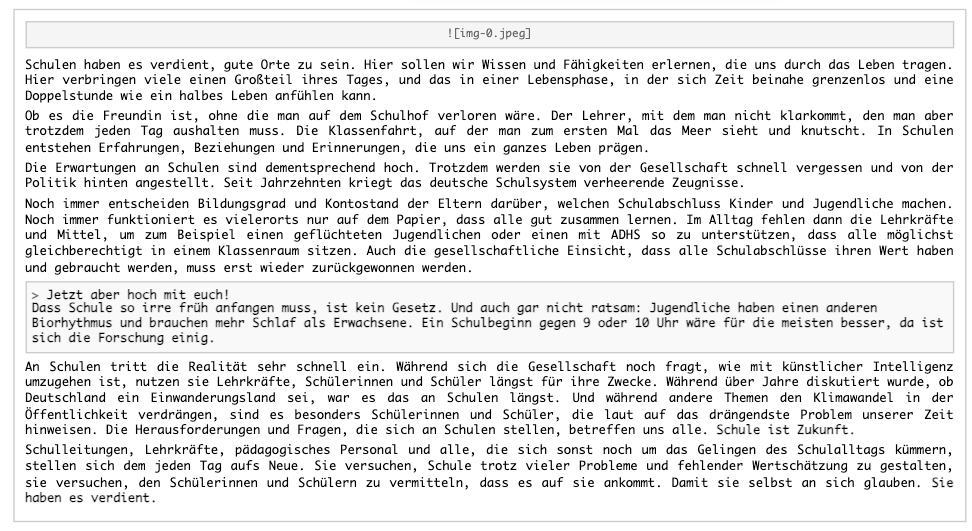
|
Astuce
Pour voir l’une de ces images à une taille plus lisible, sélectionnez-la en cliquant dessus ou en la touchant.
Ce qui suit est la commande SQL pour traiter le document original. Comme le document comporte une seule page, vous n’avez pas besoin du fractionnement de page pour cet exemple.
SELECT AI_PARSE_DOCUMENT (TO_FILE('@docs.doc_stage','german_example.pdf'),
{'mode': 'LAYOUT'}) AS german_article;
La réponse de AI_PARSE_DOCUMENT est un objet JSON contenant des métadonnées et le texte du document, comme les suivants.
{
"metadata": {
"pageCount": 1
}
"content": "\n\nSchulen haben es verdient, gute Orte zu sein. Hier sollen wir Wissen und Fähigkeiten
erlernen, die uns durch das Leben tragen. Hier verbringen viele einen Großteil ihres Tages, und das in einer Lebensphase, in
der sich Zeit beinahe grenzenlos und eine Doppelstunde wie ein halbes Leben anfühlen kann.\n\nOb es die Freundin ist, ohne die
man auf dem Schulhof verloren wäre. Der Lehrer, mit dem man nicht klarkommt, den man aber trotzdem jeden Tag aushalten muss.
Die Klassenfahrt, auf der man zum ersten Mal das Meer sieht und knutscht. In Schulen entstehen Erfahrungen, Beziehungen und
Erinnerungen, die uns ein ganzes Leben prägen.\n\nDie Erwartungen an Schulen sind dementsprechend hoch. Trotzdem werden sie
von der Gesellschaft schnell vergessen und von der Politik hinten angestellt. Seit Jahrzehnten kriegt das deutsche Schulsystem
verheerende Zeugnisse.\n\nNoch immer entscheiden Bildungsgrad und Kontostand der Eltern darüber, welchen Schulabschluss Kinder
und Jugendliche machen. Noch immer funktioniert es vielerorts nur auf dem Papier, dass alle gut zusammen lernen. Im Alltag
fehlen dann die Lehrkräfte und Mittel, um zum Beispiel einen geflüchteten Jugendlichen oder einen mit ADHS so zu unterstützen,
dass alle möglichst gleichberechtigt in einem Klassenraum sitzen. Auch die gesellschaftliche Einsicht, dass alle
Schulabschlüsse ihren Wert haben und gebraucht werden, muss erst wieder zurückgewonnen werden.\n\nJetzt aber hoch mit
euch!\nDass Schule so irre früh anfangen muss, ist kein Gesetz. Und auch gar nicht ratsam: Jugendliche haben einen anderen
Biorhythmus und brauchen mehr Schlaf als Erwachsene. Ein Schulbeginn gegen 9 oder 10 Uhr wäre für die meisten besser, da ist
sich die Forschung einig\n\nAn Schulen tritt die Realität sehr schnell ein. Während sich die Gesellschaft noch fragt, wie mit
künstlicher Intelligenz umzugehen ist, nutzen sie Lehrkräfte, Schülerinnen und Schüler längst für ihre Zwecke. Während über
Jahre diskutiert wurde, ob Deutschland ein Einwanderungsland sei, war es das an Schulen längst. Und während andere Themen den
Klimawandel in der Öffentlichkeit verdrängen, sind es besonders Schülerinnen und Schüler, die laut auf das drängendste Problem
unserer Zeit hinweisen. Die Herausforderungen und Fragen, die sich an Schulen stellen, betreffen uns alle. Schule ist Zukunft.
\n\nSchulleitungen, Lehrkräfte, pädagogisches Personal und alle, die sich sonst noch um das Gelingen des Schulalltags kümmern,
stellen sich dem jeden Tag aufs Neue. Sie versuchen, Schule trotz vieler Probleme und fehlender Wertschätzung zu gestalten,
sie versuchen, den Schülerinnen und Schülern zu vermitteln, dass es auf sie ankommt. Damit sie selbst an sich glauben. Sie
haben es verdient.",
}
snowflake cortex peut produire une traduction dans n’importe quelle langue prise en charge (anglais, code de langue 'en', dans ce cas) comme suit :
SNOWFLAKE.CORTEX.TRANSLATE (ger_example, '', 'en') from german_article;
La traduction est la suivante :
"Schools deserve to be good places. Here, we are supposed to learn knowledge and skills that will carry us through life. Many
spend a large part of their day here, and this is during a phase of life when time can seem almost endless and a double period
can feel like half a lifetime.
Whether it's the friend you would be lost without in the schoolyard. The teacher you can't get along with, but still have to
endure every day. The class trip where you see the sea for the first time and make out. In schools, experiences,
relationships, and memories are created that shape us for a lifetime.
The expectations for schools are correspondingly high. Nevertheless, they are quickly forgotten by society and pushed to the
back by politics. For decades, the German school system has been receiving devastating reports.
Even now, the level of education and the financial status of the parents still determine which school certificate children and
young people receive. It still only works on paper that everyone learns well together. In everyday life, the teachers and
resources are lacking to support, for example, a refugee youth or a student with ADHD so that they can sit in a classroom on
an equal footing. The societal insight that all school certificates have value and are needed also needs to be regained.
Now, let's get going!
The fact that school has to start so early is not a law. And it's not advisable either: teenagers have a different biological
rhythm and need more sleep than adults. A start time of 9 or 10 o'clock would be better for most, research agrees.
Reality sets in very quickly at schools. While society is still wondering how to deal with artificial intelligence, teachers,
students, and pupils are already being used for their purposes. While it was debated for years whether Germany is an
immigration country, it has been one in schools for a long time. And while other topics are pushing climate change out of the
public eye, it is especially students who are loudly pointing out the most pressing problem of our time. The challenges and
questions that schools face affect us all. School is the future.
School administrations, teachers, educational staff, and all those who take care of the success of everyday school life face
this every day. They try to shape school despite many problems and lack of appreciation, they try to convey to the students
that it's up to them. So that they believe in themselves. They deserve it."
Utilisation du mode OCR¶
le mode OCR extrait du texte de documents numérisés, tels que des captures d’écran ou des PDFs contenant des images de texte. Il ne préserve pas la mise en page.
SELECT TO_VARCHAR(
SNOWFLAKE.CORTEX.PARSE_DOCUMENT(
'@PARSE_DOCUMENT.DEMO.documents',
'document_1.pdf',
{'mode': 'OCR'})
) AS OCR;
Sortie :
{
"content": "content of the document"
}
Traiter uniquement certaines pages d’un document¶
Cet exemple illustre l’utilisation de l’option page_filter permettant d’extraire des pages spécifiques d’un document, en particulier la première page d’un document de recherche de 55 pages. Gardez à l’esprit que les index de page commencent à 0 et que les plages incluent la valeur de départ, mais pas la valeur de fin. Par exemple, start: 0, end: 1 ne renvoie que la première page (index 0).
SELECT AI_PARSE_DOCUMENT(
TO_FILE('@my_documents', 'ResearchArticle.pdf'),
{'mode': 'LAYOUT', 'page_filter': [{'start': 0, 'end': 1}]} );
Résultat :
{
"metadata": {
"pageCount": 55
},
"pages": [
{
"content": "# The Critical Role of Strength Training in Lifelong Health: Evidence-Based
Benefits and Implementation Strategies \n\n\n#### Abstract\n\nBackground: Strength training
has emerged as one of the most powerful interventions for promoting health across the
lifespan. This comprehensive review examines the extensive evidence supporting strength
training's role in preventing chronic disease, maintaining functional independence, and
enhancing quality of life.\n\nMethods: We conducted a systematic review of peer-reviewed
literature published between 2018-2024, analyzing 127 studies involving over 45,000
participants across various populations.\n\nResults: Regular resistance exercise provides
cardiovascular benefits ( $15-20 \\%$ reduction in heart disease risk), metabolic improvements
( $12-18 \\%$ better insulin sensitivity), cognitive enhancements ( $25 \\%$ slower
cognitive decline), and psychological well-being improvements. Strength training increases
bone mineral density by $1-3 \\%$ annually and reduces fall risk by up to $40 \\%$ in older
adults.\n\nConclusions: Current guidelines recommend at least two sessions per week targeting
all major muscle groups. Implementation of strength training programs should be considered a
public health priority given the substantial evidence for disease prevention and health
promotion.\n\n\nKeywords: resistance training, muscle strength, bone density, chronic
disease prevention, healthy aging, exercise prescription\n\n## Introduction\n\nThe human
musculoskeletal system is designed for regular mechanical loading and progressive challenge.
Throughout evolutionary history, our ancestors engaged in strength-demanding activities
essential for survival, maintaining robust muscle mass and bone density well into advanced age.
However, the modern sedentary lifestyle has created an unprecedented mismatch between our
biological needs and daily activities, contributing to rising rates of sarcopenia,
osteoporosis, and metabolic dysfunction.\n\nStrength training, also known as resistance
training or weight training, represents a targeted intervention that can address many
contemporary health challenges. Unlike aerobic exercise alone, resistance training provides
unique physiological adaptations that are essential for long-term health and functional
independence. The World Health Organization now recognizes strength training as a fundamental
component of physical activity guidelines for all adults.\n\nKey Statistics: Only 31\\% of
adults meet strength training recommendations, despite evidence showing $20-30 \\%$ reductions
in all-cause mortality among regular participants.\n\n## Physiological Mechanisms and
Adaptations\n\n## Musculoskeletal Benefits\n\nStrength training stimulates muscle protein
synthesis through mechanistic target of rapamycin (mTOR) pathway activation, leading to
increased muscle fiber size and improved neuromuscular coordination. Research demonstrates
that adults can increase muscle mass by $2-4 \\%$ per month during initial training phases,
with continued improvements possible throughout life.\n\nBone tissue responds to mechanical
loading through osteoblast activation and increased bone formation. Weight-bearing resistance
exercises create piezoelectric effects that stimulate osteocyte networks, resulting in
improved bone mineral density and reduced fracture risk. Studies show 1-3\\% annual",
"index": 0
}
]
}
Catégoriser plusieurs documents¶
Pour catégoriser plusieurs documents, commencez par créer une table de fichiers en récupérant les emplacements des documents à partir d’un répertoire, en convertissant ces emplacements en objets FILE.
CREATE TABLE documents_table AS
(SELECT TO_FILE('@my_documents', RELATIVE_PATH)
AS docs FROM DIRECTORY(@my_documents));
Appliquez ensuite AI_PARSE_DOCUMENT à chaque document de la table et traitez les résultats, par exemple en les transmettant à AI_CLASSIFY pour classer les documents par type. Il s’agit d’une approche efficace pour l’analyse de documents par lots dans un ensemble de documents.
WITH single_page_extraction as (
SELECT
TO_VARCHAR (AI_PARSE_DOCUMENT(docs, {'mode': 'LAYOUT',
'page_filter': [{'start': 0, 'end': 1}]} )) AS first_page FROM documents_table);
SELECT AI_CLASSIFY(
first_page,
['health', 'fitness','economics', 'science', 'psychology' ,'sociology','statistics', 'finance', 'Artificial Intelligence', 'Analytics'],
{'output_mode': 'multi'} ) as article_classification
FROM single_page_extraction;
La requête renvoie les libellés de classification pour chaque document.
{ "labels": [ "health", "psychology", "science" ] }
{ "labels": [ "fitness", "health", "science" ] }
{ "labels": [ "Analytics", "Artificial Intelligence" ] }
{ "labels": [ "finance", "Analytics" ] }
..
{ "labels": [ "finance" ] }
{ "labels": [ "Artificial Intelligence", "science" ] }
{ "labels": [ "Artificial Intelligence", "science" ] }
{ "labels": [ "fitness", "health", "science" ] }
Exigences en matière d’entrées¶
AI_PARSE_DOCUMENT est optimisé pour les documents numériques et numérisés. La table suivante répertorie les limitations et les exigences relatives aux documents d’entrée :
Taille maximale du fichier |
100 MB |
|---|---|
Nombre maximal de pages par document |
500 |
Résolution maximale de la page |
|
Types de fichiers pris en charge |
PDF, PPTX, DOCX, JPEG, JPG, PNG, TIFF, TIF, HTML, TXT |
Chiffrement de la zone de préparation |
Chiffrement côté serveur |
Taille de la police |
8 points ou plus pour les meilleurs résultats |
Fonctionnalités et limitations relatives aux documents pris en charge¶
Orientation de la page |
AI_PARSE_DOCUMENT détecte automatiquement l’orientation de la page. |
|---|---|
Fractionnement des pages |
AI_PARSE_DOCUMENT peut diviser des documents de plusieurs pages en pages distinctes et analyser chacune d’entre elles séparément. Cela est utile pour le traitement de documents volumineux qui dépassent la taille maximale. |
Filtrage des pages |
AI_PARSE_DOCUMENT peut traiter certaines pages d’un document, au lieu de toutes, grâce à la spécification de plages de pages. Cela est utile lorsque vous savez sur quelles pages se trouvent les informations que vous recherchez. |
Caractères |
AI_PARSE_DOCUMENT détecte les caractères suivants :
|
Images |
AI_PARSE_DOCUMENT génère du balisage pour les images du document, mais n’extrait pas actuellement les images réelles. |
Éléments structurés |
AI_PARSE_DOCUMENT détecte et extrait automatiquement les tables et les formulaires. |
Polices |
AI_PARSE_DOCUMENT reconnaît le texte dans la plupart des polices à empattement et sans empattement, mais peut avoir des difficultés avec les polices décoratives ou de script. La fonction ne reconnaît pas l’écriture manuelle. |
Langues acceptées¶
AI_PARSE_DOCUMENT est entraîné pour les langues suivantes :
Mode OCR |
Mode LAYOUT |
|---|---|
|
|
Disponibilité régionale¶
La prise en charge de AI_PARSE_DOCUMENT est disponible pour les comptes dans les régions Snowflake suivantes :
AWS |
Azure |
Google Cloud Platform |
|---|---|---|
US Ouest 2 (Oregon) |
Est US 2 (Virginie) |
US Central 1 (Iowa) |
US East (Ohio) |
Ouest US 2 (Washington) |
|
US East 1 (N. du Nord) |
Europe (Pays-Bas) |
|
Europe (Irlande) |
||
Europe Central 1 (Francfort) |
||
Asie-Pacifique (Sydney) |
||
Asie-Pacifique (Tokyo) |
AI_PARSE_DOCUMENT dispose d’une prise en charge interrégionale. pour plus d’informations sur l’activation de la prose en charge interrégionale de cortex AI, consultez Inférence interrégionale.
Exigences en matière de contrôle d’accès¶
Pour utiliser la fonction AI_PARSE_DOCUMENT, un utilisateur ayant un rôle ACCOUNTADMIN doit accorder le rôle de base de données SNOWFLAKE.CORTEX_USER à l’utilisateur qui appellera la fonction. Consultez la rubrique Privilèges LLM Cortex pour plus de détails.
Considérations relatives aux clients¶
La fonction Cortex AI_PARSE_DOCUMENT engendre des coûts de calcul basés sur le nombre de pages par document traité. Ce qui suit décrit comment les pages sont comptées pour différents formats de fichiers :
Pour les formats de fichiers paginés (PDF, DOCX), chaque page du document est facturée comme une page.
Pour les formats d’images (JPEG, JPG, TIF, TIFF, PNG), chaque fichier d’image est facturé comme une page.
Pour les fichiers HTML et TXT, chaque morceau de 3 000 caractères est facturé comme une page, y compris le dernier morceau, qui peut être inférieur à 3 000 caractères.
Snowflake recommande d’exécuter les requêtes qui font appel à la fonction Cortex AI_PARSE_DOCUMENT dans un entrepôt plus petit (pas plus grand que MEDIUM). Des entrepôts plus grands n’augmentent pas les performances.
Conditions d’erreur¶
Snowflake Cortex AI_PARSE_DOCUMENT peut produire les messages d’erreur suivants.
Message |
Explanation |
|---|---|
|
Input document contains unsupported language. |
|
The document is in unsupported format. |
|
The file format is not supported and understood as a binary file. |
|
The document exceeds the 500-page limit. |
|
Image input or a converted document page is larger than the supported dimensions. |
|
Page is larger than the supported dimensions. |
|
The document is larger than 100 MB. |
|
The file does not exist. |
|
The file can’t be accessed due to insufficient privileges. |
|
Un délai d’expiration s’est produit. |
|
System error occurred. Wait and try again. |
Avis juridiques¶
La classification des données d’entrées et de sorties est présentée dans la table suivante.
Classification des données d’entrée |
Classification des données de sortie |
Désignation |
|---|---|---|
Usage Data |
Customer Data |
Les fonctions généralement disponibles sont des fonctions AI couvertes. Les fonctions d’aperçu sont les fonctions AI d’aperçu. [1] |
Pour plus d’informations, reportez-vous à Snowflake AI et ML.